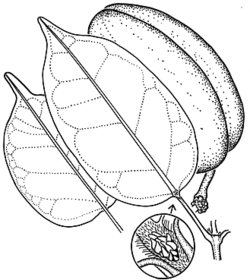Common name: Milk Vine
Marsdenia rostrata R.Br. APNI* 
Description: Climber to c. 10 m high, latex copious, milky.
Leaves with lamina oblong-elliptic to broad-ovate, sometimes ± circular, 1.2–3 times as long as broad, 4–13 cm long, 2–7 cm wide, apex mostly abruptly narrowed to a short or long obtuse point, base rounded or slightly cordate, glabrous, margins flat; larger net veins distinct on lower surface; petiole 10–40 mm long.
Flowers 7–12 mm diam., pale yellow. Corolla lobes spreading, oblong-obtuse, hairy inside to middle or above, 3–6 mm long; tube c. 2 mm long. Style head narrow-conical, 2-fid, much longer than anthers. Free part of corona segments erect, incurved, nearly as long as the anthers; wings and auricles absent.
Follicles turgid, ovoid, obtuse or with a short point, 5–7 cm long, 2–4 cm diam.
Flowering: spring–summer.
Distribution and occurrence: Grows in most types of rainforest and wet sclerophyll forest; widespread in coastal districts and inland to the Liverpool Ra. and the Goulburn R. valley.
NSW subdivisions: NC, CC, SC, NT, CT, ST, NWS, CWS, LHI
Other Australian states: Qld Vic.
Text by G. J. Harden & J. B. Williams
Taxon concept: P.I. Forster (1995)
APNI* Provides a link to the Australian Plant Name Index (hosted by the Australian National Botanic Gardens) for comprehensive bibliographic data
***The AVH map option provides a detailed interactive Australia wide distribution map drawn from collections held by all major Australian herbaria participating in the Australian Virtual Herbarium project.
|


